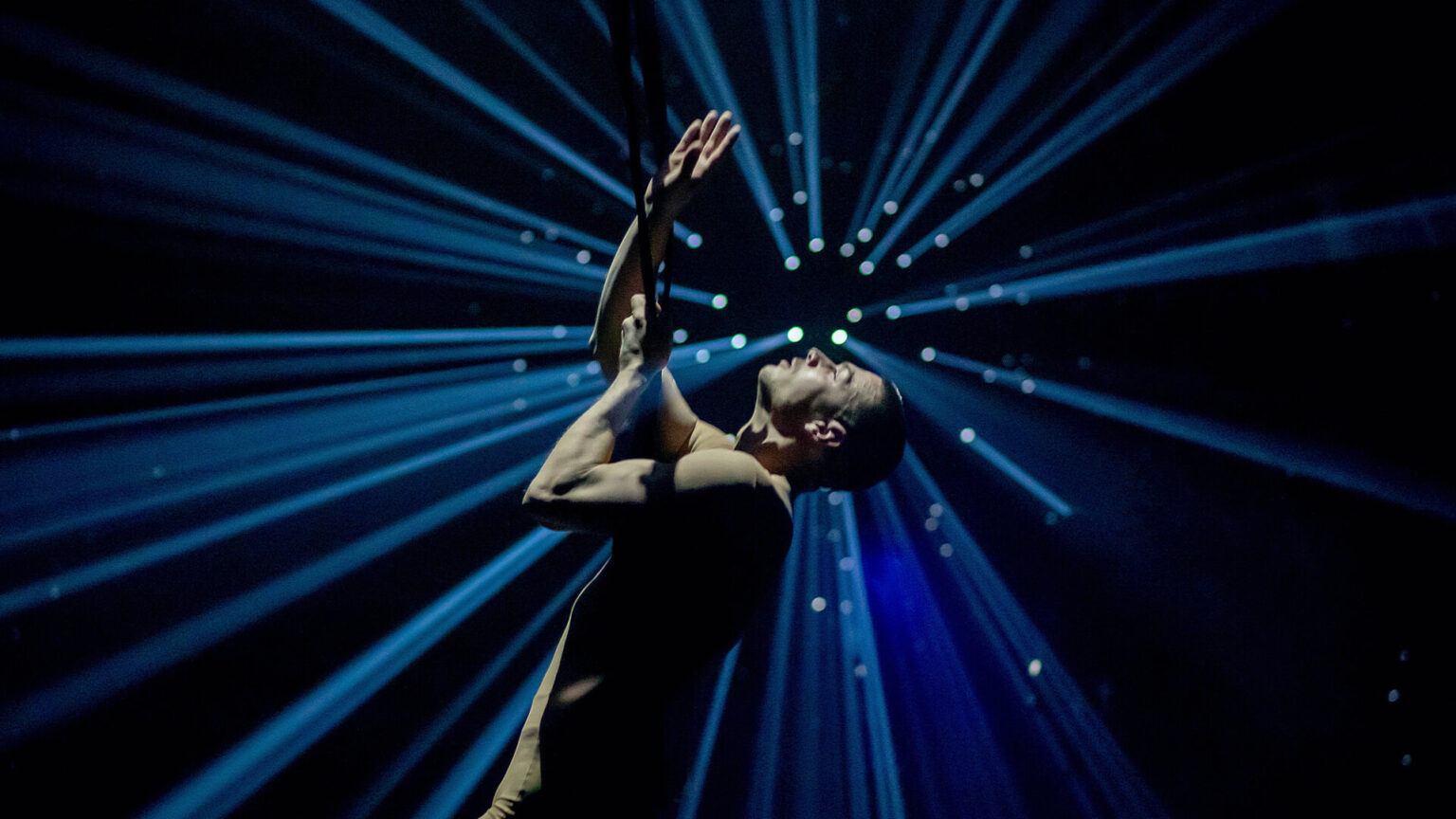Review from: Assembly at Murrayfield Ice Arena, Edinburgh Festival Fringe; 25th August 2023
Vastness, the cosmos, and a single figure – human shaped – navigating the void for 40 minutes. The installation and aerial performance created by Bence Vági, and featuring a rotating cast of six alternate performers, is a taste of eternity; a haven of composure that allows us to escape from the hustling, bustling human world of Edinburgh during August. In Hungary, where Recirquel are based, the title means ‘pray’ and is pronounced to rhyme with swimmer, not – as I had imagined – as a three-letter abbreviation of a longer phrase. I dislike titles presented all in capital letters at the best of times but, as it turns out, this is the only criticism I can level at the accomplished production.
Disclaimer: I have been a fan of Vági’s work for a long time. His polished aesthetic and ideals of beauty speak to my own, and his productions values are high enough to achieve them. These qualities pervade the entire IMA experience, but the immersive installation format is a departure from the previous shows I’ve seen from the company. I was unsure what to expect, but was richly rewarded.
The first part of the experience involves a cavernous antechamber, carpeted all over in misty grey. A central dais hosts a giant wall of shimmering wishes, gauzy ribbons tied to a net. There is an ancient, reverential feeling, and – perhaps from the altar-like steps to the central wall, perhaps from the colourlessness, perhaps from the piped sounds of bells and prayer bowls – I am reminded of Greek myths and underworld stories. It is not warm. It is not cold. It is not light. It is not dark. It is not good. It is not bad. An ambivalent, endless, unformed place of possibilities. A purgatory, filling with souls, in which to reflect, to wait, and to contemplate what may ensue.
Once the space is filled, a passageway opens up that leads us into the vast universe. A tented canopy of black, glittering with far away stars and, at its centre, a central figure draped in diaphanous white. We ring the figure, settling onto small dense beanbags or higher stools. They are black. The floor is black. The performance area is black, distinguished only as a circular area of reflective sheen. A cosmic soundtrack of extending tones evokes the music of the spheres, and I feel a sudden rush of emotion that there can be such beautiful experiences in the world.
Unseen fans ripple the central being’s robes and, as a sonic crescendo builds, the figure slowly turns. Today, the role is performed by Gábor Zsíros, and I wonder how the allotted artist affects the overall impact of the event. If I had longer at the Fringe I would return, over and over, to find out.
The being moves about towards the limits of their circle, offering their hands to us, bestowing unknown gifts of reverence. Shafts of light highlight contours of muscle under skin and, as the celestial bodies seem to shift around us, we are all fleetingly captured in the starlight, fragments of forever. Choral notes add to the sonic score, and an aerial loop lowers slowly towards the ground. It too is black, assisting in illusions of flight or suspension as Zsíros is raised aloft. Despite our focus on his graceful figure and balletic poses, the experience is a holistic one in which he is an emblem or an archetype, rather than a character. Director/choreographer Vági is a visionary, and IMA is about the vision, not the individual aerial interpreter. Attila Lenzsér’s impeccable lighting design works particular magic to realise this vision.
Zsíros’ movements are not not just slow, they are smoooooooth. A controlled, perpetual motion that suggests an eternal pattern that we are witnessing only moments from. The few, tiny drops have impact beyond their size. Eternity never looked so enticing.
But… a minor key enters the music. Does this celestial infinity have its downsides? Do the hands outstretched towards us now entreat? The pace picks up with spins and a seeming search for release. An inescapable eternity of of grace and beauty is still an inescapable eternity. As the orchestral sounds fade to solo piano, a serenity of acceptance is restored, ascending again to a fantasy of necessary bliss. If this is the existence of angels, I sense why some fall. Or, perhaps this is a story of birth: not taking a dark path, but choosing a mortal one?
Finally, as the being turns and walks towards our portal home, it is just us remaining amid the deepening starlight. I had wondered how we would leave such a transcendent space, but the spell is broken in a safely conventional manner. The lights go up, and we applaud the returned performer. He is there again as we leave, a smiling, human one of us.
Not only has this show been one of my favourite circus encounters, it is also my favourite kind of show to write about. Inspirational and poetic. I am aware of how closely my reading of the visuals surrounding me is tied to my own spiritual viewpoint, and am certain others can experience the material in their own ways. So now I’m excited to head off and read other reviewer’s takes on their experience… although I already know from the Fringe poster publicity that the stars will abound there as they did in our temporary timelessness!
Installation conceived by: Bence Vági and Tamás Vladás
Original music: Edina “Mókus” Szirtes
Sound design: Gábor Terjék
Lobby design: Árpád Iványi
Costume design: Emese Kasza



